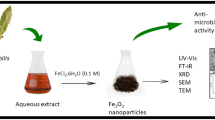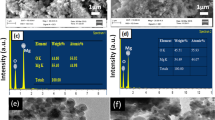Abstract
Amalgamation of nanoparticles using “Green Technology” is an intensive field of research due to the increase in the need for the development of new antimicrobial materials. This method is meritorious both in environmental and economic aspects. In the present study, synthesis of titanium dioxide nanoparticles (TiO2 NPs) was done using the aqueous extract of Laurus nobilis (bay leaf). The characterization was done using UV–visible absorption spectroscopy, X-ray diffraction (XRD), Fourier transform infrared spectroscopy (FTIR), scanning electron microscopy (SEM), particle size, and zeta potential analyses. Successful production of nanoparticles was confirmed by the presence of spherical-shaped TiO2 NPs with the size of ~ 100 nm. The nanoparticles were tested against pathogens to determine their antibacterial and antifungal activities. The antimicrobial and antifungal activities with various concentrations for the generated TiO2 NPs were investigated and the results showed that the synthesised nanoparticles manifested a good inhibitory activity against both the tested bacteria and the fungal strain. Bacillus subtilis and Aspergillus niger showed better zone of inhibition against nanoparticle. The observation is that the inhibition zone increases proportionately with the increased nanoparticles concentration. The as-prepared nanoparticles were also subjected to free radical scavenging ability using DPPH and hydrogen peroxide assays. TiO2 NPs revealed a strong antioxidant activity when compared with ascorbic acid standard. Current study concludes that the concocted TiO2 NPs, using L. nobilis bay leaf, can be scaled up for large-scale industrial production, which would be eco-friendly, economic with a high productivity.








Similar content being viewed by others
References
Ajmal N, Saraswat K, Bakht MA, Riadi Y, Ahsan MJ, Noushad M (2019) Cost-effective and eco-friendly synthesis of titanium dioxide (TiO2) nanoparticles using fruit’s peel agro-waste extracts: characterization, in vitro antibacterial, antioxidant activities. Green Chem Lett Rev 12(3):244–254
Ali BM, Boothapandi M, Nasar AS (2020) Nitric oxide, DPPH and hydrogen peroxide radical scavenging activity of TEMPO terminated polyurethane dendrimers: Data supporting antioxidant activity of radical dendrimers. Data Brief 28:104972
Allahverdiyev AM, Abamor ES, Bagirova M, Rafailovich M (2011) Antimicrobial effects of TiO2 and Ag2O nanoparticles against drug-resistant bacteria and leishmania parasites. Future Microbiol 6(8):933–940
Anas A, Wiersinga W, De Vos A, Van der Poll T (2010) Recent insights into the pathogenesis of bacterial sepsis. Neth J Med 68(4):147–152
Aviram M (2000) Review of human studies on oxidative damage and antioxidant protection related to cardiovascular diseases. Free Radic Res 33:S85-97
Azouri A, Ge M, Xun K, Sattler K, Lichwa J, Ray C (2006) Zeta potential studies of titanium dioxide and silver nanoparticle composites in water-based colloidal suspension. In: Multifunctional Nanocomposites and Nanomaterials International Conference, 2006, pp. 221–223
Badnore AU, Sorde KI, Datir KA, Ananthanarayan L, Pratap AP, Pandit AB (2019) Preparation of antibacterial peel-off facial mask formulation incorporating biosynthesized silver nanoparticles. Appl Nanosci 9(2):279–287
Batool S, Khera RA, Hanif MA, Ayub MA (2020) Bay leaf, medicinal plants of South Asia. Elsevier, pp 63–74
Dobrucka R (2017) Synthesis of titanium dioxide nanoparticles using Echinacea purpurea herba. Iran JPharm Res IJPR 16(2):756
Dréno B, Alexis A, Chuberre B, Marinovich M (2019) Safety of titanium dioxide nanoparticles in cosmetics. J Eur Acad Dermatol Venereol 33:34–46
Elmastaş M, Gülçin I, Işildak Ö, Küfrevioğlu Ö, İbaoğlu K, Aboul-Enein H (2006) Radical scavenging activity and antioxidant capacity of bay leaf extracts. J Iran Chem Soc 3(3):258–266
Feynman RP (1960) There’s plenty of room at the bottom. California Institute of Technology, Engineering and Science Magazine
Gong P, Li H, He X, Wang K, Hu J, Tan W, Zhang S, Yang X (2007) Preparation and antibacterial activity of Fe3O4@ Ag nanoparticles. Nanotechnology 18(28):285604
Halliwell B (2001) Role of free radicals in the neurodegenerative diseases. Drugs Aging 18(9):685–716
Hitchon CA, El-Gabalawy HS (2004) Oxidation in rheumatoid arthritis. Arthritis Res Ther 6(6):1–14
Ijadpanah-Saravy H, Safari M, Khodadadi-Darban A, Rezaei A (2014) Synthesis of titanium dioxide nanoparticles for photocatalytic degradation of cyanide in wastewater. Anal Lett 47(10):1772–1782
Imran K, Mohd F, Pratichi S, Padma T (2014) Nanotechnology for environmental remediation. Res J Pharm Biol Chem Sci 5(3):1916–1927
Jafari S, Mahyad B, Hashemzadeh H, Janfaza S, Gholikhani T, Tayebi L (2020) Biomedical applications of TiO2 nanostructures: recent advances. Int J Nanomed 15:3447
Kaliprasad C, Narayana Y (2018) A review on application of nanoparticles in biophysics. Res Rev J Phys 7(3):63–65
Khan I, Saeed K, Khan I (2019) Nanoparticles: Properties, applications and toxicities. Arab J Chem 12(7):908–931
Khezerlou A, Alizadeh-Sani M, Azizi-Lalabadi M, Ehsani A (2018) Nanoparticles and their antimicrobial properties against pathogens including bacteria, fungi, parasites and viruses. Microb Pathog 123:505–526
Klaunig JE, Kamendulis LM (2004) The role of oxidative stress in carcinogenesis. Annu Rev Pharmacol Toxicol 44:239–267
Kozan E, Küpeli E, Yesilada E (2006) Evaluation of some plants used in Turkish folk medicine against parasitic infections for their in vivo anthelmintic activity. J Ethnopharmacol 108(2):211–216
Krithiga N, Rajalakshmi A, Jayachitra A (2015) Green synthesis of silver nanoparticles using leaf extracts of Clitoria ternatea and Solanum nigrum and study of its antibacterial effect against common nosocomial pathogens. J Nanosci. https://doi.org/10.1155/2015/928204
Kruis FE, Fissan H, Rellinghaus B (2000) Sintering and evaporation characteristics of gas-phase synthesis of size-selected PbS nanoparticles. Mater Sci Eng B 69:329–334
Lai Y, Wang L, Liu D, Chen Z, Lin C (2015) TiO2-based nanomaterials: design, synthesis, and applications. Hindawi. https://doi.org/10.1155/2015/250632
Lobo V, Patil A, Phatak A, Chandra N (2010) Free radicals, antioxidants and functional foods: impact on human health. Pharmacogn Rev 4(8):118
Madasamy S, Sundan S, Krishnasamy L (2020) Preparation of cold cream against clinical pathogen using Caralluma adscendens var. attenuata. Asian J Pharm Clin Res 13(9):120–123
Magnusson MH, Deppert K, Malm J-O, Bovin J-O, Samuelson L (1999) Gold nanoparticles: production, reshaping, and thermal charging. J Nanopart Res 1(2):243–251
Mattiello A, Marchiol L (2017) Application of nanotechnology in agriculture: assessment of TiO2 nanoparticle effects on barley. In: Janus M (ed) Application of titanium dioxide. InTech, London, pp 23–39
Mohajerani A, Burnett L, Smith JV, Kurmus H, Milas J, Arulrajah A, Horpibulsuk S, Abdul Kadir A (2019) Nanoparticles in construction materials and other applications, and implications of nanoparticle use. Materials 12(19):3052
Mukherjee P, Ahmad A, Mandal D, Senapati S, Sainkar SR, Khan MI, Ramani R, Parischa R, Ajayakumar P, Alam M (2001) Bioreduction of AuCl4− ions by the fungus, Verticillium sp. and surface trapping of the gold nanoparticles formed. Angew Chem Int Ed 40(19):3585–3588
Nadaroglu H, Güngör AA, Selvi İ (2017) Synthesis of nanoparticles by green synthesis method. Int J Innov Res Rev 1(1):6–9
Nath B, Barbhuiya T (2014) Studies on the density and surface area of nanoparticles from Camellia sinensis, A natural source. J Chem Pharm Res 6(11):608–610
Nayak S, Nalabothu P, Sandiford S, Bhogadi V, Adogwa A (2006) Evaluation of wound healing activity of Allamanda cathartica. L. and Laurus nobilis. L. extracts on rats. BMC Complement Altern Med 6(1):12
Nunomura A, Castellani RJ, Zhu X, Moreira PI, Perry G, Smith MA (2006) Involvement of oxidative stress in Alzheimer disease. J Neuropathol Exp Neurol 65(7):631–641
Ozcan B, Esen M, Sangun MK, Coleri A, Caliskan M (2010) Effective antibacterial and antioxidant properties of methanolic extract of Laurus nobilis seed oil. J Environ Biol 31(5):637–641
Pestovsky YS, Martínez-Antonio A (2017) The use of nanoparticles and nanoformulations in agriculture. J Nanosci Nanotechnol 17(12):8699–8730
Rattan SI (2006) Theories of biological aging: genes, proteins, and free radicals. Free Radic Res 40(12):1230–1238
Rodríguez-González V, Terashima C, Fujishima A (2019) Applications of photocatalytic titanium dioxide-based nanomaterials in sustainable agriculture. J Photochem Photobiol, C 40:49–67
Salata OV (2004) Applications of nanoparticles in biology and medicine. J Nanobiotechnol 2(1):3
Samejima K, Kanazawa K, Ashida H, Danno G-I (1998) Bay laurel contains antimutagenic kaempferyl coumarate acting against the dietary carcinogen 3-amino-1-methyl-5 H-pyrido [4, 3-b] indole (Trp-P-2). J Agric Food Chem 46(12):4864–4868
Santhoshkumar T, Rahuman AA, Jayaseelan C, Rajakumar G, Marimuthu S, Kirthi AV, Velayutham K, Thomas J, Venkatesan J, Kim S-K (2014) Green synthesis of titanium dioxide nanoparticles using Psidium guajava extract and its antibacterial and antioxidant properties. Asian Pac J Trop Med 7(12):968–976
Santos FW, Graça DL, Zeni G, Rocha JB, Weis SN, Favero AM, Nogueira CW (2006) Sub-chronic administration of diphenyl diselenide potentiates cadmium-induced testicular damage in mice. Reprod Toxicol 22(3):546–550
Sawhney APS, Condon B, Singh KV, Pang S-S, Li G, Hui D (2008) Modern applications of nanotechnology in textiles. Text Res J 78(8):731–739
Sethy NK, Arif Z, Mishra PK, Kumar P (2020) Green synthesis of TiO2 nanoparticles from Syzygium cumini extract for photo-catalytic removal of lead (Pb) in explosive industrial wastewater. Green Process Synth 9(1):171–181
Sharfudeen BFJM, Latheef AFA, Ambrose RV (2017) Synthesis and characterization of TiO2 nanoparticles and investigation of antimicrobial activities against human pathogens. J Pharm Sci Res 9(9):1604
Sharma D, Kanchi S, Bisetty K (2019) Biogenic synthesis of nanoparticles: a review. Arab J Chem 12(8):3576–3600
Siddiqi KS, Husen A, Rao RA (2018) A review on biosynthesis of silver nanoparticles and their biocidal properties. J Nanobiotechnol 16(1):14
Singh R, Chidambara Murthy K, Jayaprakasha G (2002) Studies on the antioxidant activity of pomegranate (Punica granatum) peel and seed extracts using in vitro models. J Agric Food Chem 50(1):81–86
Singh T, Shukla S, Kumar P, Wahla V, Bajpai VK, Rather IA (2017) Application of nanotechnology in food science: perception and overview. Front Microbiol 8:1501
Singhal G, Bhavesh R, Kasariya K, Sharma AR, Singh RP (2011) Biosynthesis of silver nanoparticles using Ocimum sanctum (Tulsi) leaf extract and screening its antimicrobial activity. J Nanopart Res 13(7):2981–2988
Sofyan N, Ridhova A, Yuwono AH, Udhiarto A (2017) Fabrication of solar cells with TiO2 nanoparticles sensitized using natural dye extracted from mangosteen pericarps. Int J Technol 8(7):1229–1238
Stocker R, Keaney JF Jr (2004) Role of oxidative modifications in atherosclerosis. Physiol Rev 84(4):1381–1478
Szabo C (2009) Role of nitrosative stress in the pathogenesis of diabetic vascular dysfunction. Br J Pharmacol 156(5):713–727
Tian J, Hu J, Li F, Ni M, Li Y, Wang B, Xu K, Shen W, Li B (2016) Effects of TiO2 nanoparticles on nutrition metabolism in silkworm fat body. Biology Open 5(6):764–769
Varshney R, Bhadauria S, Gaur M (2010) Biogenic synthesis of silver nanocubes and nanorods using sundried Stevia rebaudiana leaves. Adv Mat Lett 1(3):232–237
Wan J, Song T, Flox C, Yang J, Yang Q-H, Han X (2015) Advanced nanomaterials for energy-related applications. Hindawi. https://doi.org/10.1155/2015/564097
Wood-Kaczmar A, Gandhi S, Wood N (2006) Understanding the molecular causes of Parkinson’s disease. Trends Mol Med 12(11):521–528
Yadav K, Singh J, Gupta N, Kumar V (2017) A review of nanobioremediation technologies for environmental cleanup: a novel biological approach. J Mater Environ Sci 8(2):740–757
Zand AD, Mikaeili Tabrizi A, Vaezi Heir A (2020) Application of titanium dioxide nanoparticles to promote phytoremediation of Cd-polluted soil: contribution of PGPR inoculation. Bioremed J 24(2–3):171–189
Acknowledgements
This study was funded by Taif University Researchers Supporting Project number (TURSP- 2020/157), Taif University, Taif, Saudi Arabia. The authors thank King Khalid University for collaboration and support.
Author information
Authors and Affiliations
Corresponding author
Ethics declarations
Conflict of interest
The authors declare that they have no known competing financial interests or personal relationships that could have appeared to influence the work reported in this paper.
Additional information
Publisher's Note
Springer Nature remains neutral with regard to jurisdictional claims in published maps and institutional affiliations.
Rights and permissions
About this article
Cite this article
Rajeswari, V.D., Eed, E.M., Elfasakhany, A. et al. Green synthesis of titanium dioxide nanoparticles using Laurus nobilis (bay leaf): antioxidant and antimicrobial activities. Appl Nanosci 13, 1477–1484 (2023). https://doi.org/10.1007/s13204-021-02065-2
Received:
Accepted:
Published:
Issue Date:
DOI: https://doi.org/10.1007/s13204-021-02065-2




